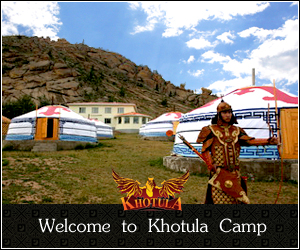Religions of the Great Mongol Empire
 The most interesting period of the religious attitudes of the Mongols was the period when Genghis Khan founded the Great Mongol Empire. Genghis Khan and his successors idolized Shamanism and holy spirits. The shamans, who worshiped the Eternal Blue Sky, were never banned by other religious denominations.
The most interesting period of the religious attitudes of the Mongols was the period when Genghis Khan founded the Great Mongol Empire. Genghis Khan and his successors idolized Shamanism and holy spirits. The shamans, who worshiped the Eternal Blue Sky, were never banned by other religious denominations.
Karakorum, the capital of Great Mongol Empire, was one of the great cultural, religious and political center of the world. Buddhists, Christians, Nestorians, Muslims and Confucians co-existed by setting up their own temples and monasteries. History tells us that the monasteries and temples had their own governing centers and head authorities. The Judaist doctrine allowed its citizens to follow Buddhist teachings. In Karakorum, along with shamanism, there was a Buddhist lamasery, two mosques, one Christian church and 12 temples of other religions. Beginning with the Great Khan, Genghis, the Mongolian Khans and nobles never discriminated against the religious denominations of conquered nations and let them co-exist on an equal footing. Khubilai Khan celebrated in his own country the festivities of various religions. The history of Yuan dynasty says that people observed together such festivals as the birthday of Christ and his rebirth. The same was observed by Muslims who celebrated Jewish and Buddhist religious events. Khubilai said, ŌĆ£These four holy saints are being deeply revered by the people in any corner of the worldŌĆØ. The Mongols treated with great tolerance the religious faiths of any nationality that helped them to rule the country they dominated, according to the historians. On the other hand, it would be wrong to say the Mongol Khans and nobles, who learned much by traversing half of the world, were the people to discriminate against other beliefs.
The history of Yuan dynasty says that people observed together such festivals as the birthday of Christ and his rebirth. The same was observed by Muslims who celebrated Jewish and Buddhist religious events. Khubilai said, ŌĆ£These four holy saints are being deeply revered by the people in any corner of the worldŌĆØ. The Mongols treated with great tolerance the religious faiths of any nationality that helped them to rule the country they dominated, according to the historians. On the other hand, it would be wrong to say the Mongol Khans and nobles, who learned much by traversing half of the world, were the people to discriminate against other beliefs.
It is probable that the wise and sound policy of Mongol Khans and high-ranking nobles of the time was the secret of the successful conquering of the half of the world. A historical fact notes: Once Munkh Khan called Rubruck, a missionary of Ludowick XI of France and talked with him about religion: ŌĆ£Though we, the Mongols, believe in the existence of only one god (burhan), but like burhan made the fingers of a man in different shape, different were the paths he showed to people. God offered you his teachings and you are not following them. Allot us with healers and soothsaying magicians. We will live in this world following their instructions.ŌĆØ These words, on one hand, prove that Munkh Khan himself was a follower of the shamanist religion, and on the other hand, indicates that he respected and allowed people to follow their particular religious faiths.
 Humankind does not know of the peaceful co-existence of different religions under one roof as in the period of the Great Mongol Empire of the 13th century. The Polish scientist V.Kotwich concludes that in the 13th century the Mongols initiated world peace, bringing the religious policy of the Mongol Khans to light a an historical fact. Another historical example is that Marco Polo’s adventure became an inspiration for the later explorations of European navigators(World History, Volume I. 4th edition. 1996, page 170). Meanwhile Mongolia’s Kazakhs are Muslims. Islam is mainly practiced in Bayan Olgii, the most western province in Mongolia. Since the mid 1990, large number of Christians, Bahais and Mormons have arrived in Mongolia seeking to convert Mongolians from Buddhist to their various faiths.
Humankind does not know of the peaceful co-existence of different religions under one roof as in the period of the Great Mongol Empire of the 13th century. The Polish scientist V.Kotwich concludes that in the 13th century the Mongols initiated world peace, bringing the religious policy of the Mongol Khans to light a an historical fact. Another historical example is that Marco Polo’s adventure became an inspiration for the later explorations of European navigators(World History, Volume I. 4th edition. 1996, page 170). Meanwhile Mongolia’s Kazakhs are Muslims. Islam is mainly practiced in Bayan Olgii, the most western province in Mongolia. Since the mid 1990, large number of Christians, Bahais and Mormons have arrived in Mongolia seeking to convert Mongolians from Buddhist to their various faiths.
 Christianity
Christianity
Christianity came to the Mongolian steppes introduced by Nestorian missionaries from Central Asia as early as the 7th century. Yet many Mongols held fast to their belief in Shamanism. By the end of the 16th century many Mongols had converted to Lama Buddhism. The Mongolia today is rather traditional. But Christianity would not have even crossed the border if it hadnŌĆÖt been for Kublai Khan whose mother was a Christian. He was the grandson of Genghis Khan and ruled when the Mongol Empire had reached its limit. It could not expand any farther, so Kublai concentrated on maintaining peace in his borders. When Marco Polo (1254 – 1323?) journeyed to China, he found evidence of Christian communities and served in the court of Kublai having become the KhanŌĆÖs trusted friend. Kublai became interested in Christianity and even asked the PoloŌĆÖs to bring back teachers and missionaries to his land. This request was never fulfilled. This may be one of the greatest loss of missionary opportunities. Due to a continuing lack of Christian influence, the land remained in its Buddhist lifestyle..
Source: www.hyperhistory.net













It rained here all day, so I decided to read some blog posts. Very nice write up here!